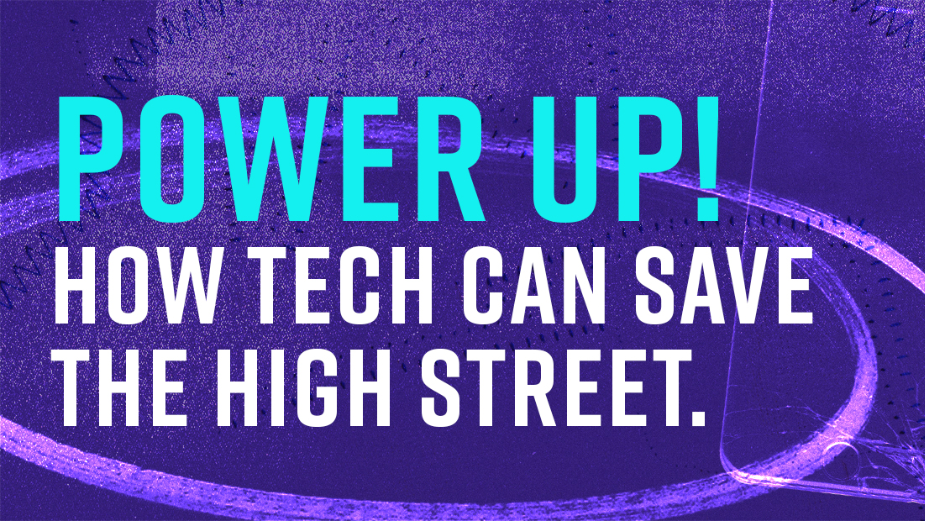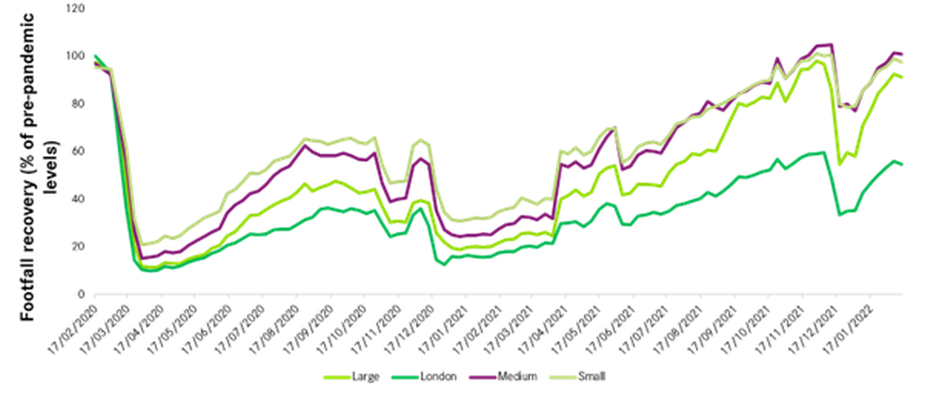
Power Up! How Tech Can Save the High Street

Our client Primark has recently confirmed they are looking to start running a click-and-collect service for kids clothes in the near future, and it got me thinking how technology is going to play a big part in helping high-street retailers adapt to the new world they are operating in, after a monumentally disruptive couple of years.
For me, it boils down to three main benefits that technology can bring for retailers, when considering where to invest their budget and time:
● Technology can give more control to their shoppers to encourage higher footfall in-store
● It can help optimise stock control to reduce business costs
● Experiential technology helps keep shoppers in-store for longer and encourages more spend
Now, while the benefits are clear, embracing the right technology to achieve this is easier said than done. This article explores how technology is making retailers adapt and what a roadmap for technological success might look like in the coming years.
Times have been tough for the high-street
The pandemic hit high-street retailers hard. We all know that.
The biggest cities felt it the hardest, too. At one point, in some of the worst hit high streets (like London), footfall was as low as 10% of pre-pandemic levels and has only recovered to 50% in recent months.
While this doesn't sound great, a recent centreforcities blog shows the picture for retailers is looking better and that things are recovering. Slowly but surely, things are getting back to something we might call normal, although the pace of recovery in bigger cities is much slower than the rest.

But that doesn't mean shoppers are the same.
48% moved online due to the pandemic and spend around 4 hours a day online on their phones.
Regardless of where their customers are shopping, high-retailers need to fight for some of that digital attention in a way that makes the trip to previously-thriving hotspots like Regent Street worthwhile.
In-store experiences need to get better
There's some good news here to consider about how shoppers like to shop and the benefits that bricks-and-mortar retail brings to their purchasing decisions, according to the latest ‘State of Fashion’ Report from the Business of Fashion
● 60% still want to try and see things on
● 50% want to take things home immediately after buying them.
Additionally, in the case of retailers like Next (who relied heavily on online purchases through the pandemic), the lure of free returns from online purchases is fading (they now charge £1.95 to return items), as they start to feel the bite of serial refunders and the rise of influencer un-boxings.
According to BoF, 20% of customers weren't happy with online returns and delivery anyway.
So, there's incentive for consumers to hit the high-street again. That doesn't mean, however, fashion retailers can just default to the status quo of old and expect to ever recover the footfall losses they've experienced. Shoppers need a little extra to go a long way (literally and figuratively).
Digital shopping is on the rise, yes. But that doesn't mean bricks-and-mortar retailers can't leverage technology to enhance the customer experience and lure shoppers into a physical store.
Technology as an enabler
Technology isn't going to solve everything, but it can provide a platform to enhance what already exists.
For most consumers, they'll go to stores for one of two things - experience or convenience (sometimes both).
Experience can mean anything from creating new social connections to entertainment in-store.
Nike's House of Innovation does a great job of bringing these things together. Whether it's giving shoppers a way to customise their sneakers, or blending the digital and physical worlds with their Roblox-based Nikeland, it's a sneak peak at what the future of shopping experiences might be. The challenge here is the investment and ambition needed to achieve it. Nike are market leaders and have the clout (and budgets) to pull off these kinds of experiments. Not every retailer has the same scope - at least not in the immediate future. But fashion brands like Gucci and Vans are ramping up their metaverse strategy and exploring ways to recruit lifetime customers through this new experiential technology already.
Convenience, however, is most likely where most retailers can make an impact quickly, with the right technology and infrastructure.
Zara have shown how micro-fulfilment in-store can have a massive impact. From seeing what's in stock and booking fitting rooms, to joining a virtual queue for purchases, it's these enhancements to the physical shopping experience that stand out - particularly as one of the biggest reasons for people not to go in-store is because it's 'too time consuming'.
The thing with convenience is the same technology that enhances the in-store experience also enhances the mobile experience. Which means people have access to this technology at home. Amazon are just the latest to launch a virtual shoe try-on feature on their online store, and the advancements in body tracking technology mean full outfit try-ons are going to be more than just a pandemic trend.
So it's not just a 'we have it too' kind of thing with technology. Going in-store needs to add something to the shopping experience as a whole - finding the right mix of technologies to do this is vital to staying relevant and respected by consumers.
Not just a marketing ploy
While it might seem that things like the metaverse and micro-fulfilment are just the latest in an ongoing trend of marketing buzzwords and hype, there's real business benefits to considering their use.
There's the increased engagement: customers interacting and sharing what they're up to at the shops - if it stands out and is worthy of note. Creating buzz about what it means to be in-store can increase footfall and get people out of their chair (literally!) to visit something that feels unique.
More importantly (at least to the immediate bottom line) is the increased retention and higher spend you'll get from the customers who've made the extra effort to visit the high-street:
● Customers who engage with tech in-store (e.g. magic mirrors, connected hangars, interactive holograms, etc) end up spending 4 times longer shopping
● Business costs through micro-fulfilment have been shown to be reduced by up to 40% (largely due to stock optimisation and reduced shipping costs).
A higher chance of your customers spending more, against a landscape of reduced costs for the business. Sounds like a roadmap to some kind of success!
What can retailers do?
For most high-street retailers, short term cash flow and a shift back to profits is the priority. What they shouldn't lose sight of is what will give them more sustainable returns in the medium to long term.
If anything, they should be investing in a shopping experience that will deliver an increase in footfall, higher customer retention and a reduction in business cost.
Like with Zara, and more recently with Primark, consider how to make that purchasing decision even easier by embracing technology that works to make things easier for the consumer. Empower them to feel in control of whether it's worth the trip into town by giving them confidence they'll be able to walk out of the shop with the look they wanted. If there's a way to help them avoid the dreaded queue at checkout too, even better. Getting them in store also means you're able to cross and upsell those more impulsive buys, as long as you're not too heavy-handed about it.
Connect what's happening at the front of your store to what's going on in the back by investing in technology that improves your supply chain management. The more control you have over stock levels and last-mile delivery operations, the more you can optimise your operating costs and, importantly, get a better margin across your stores - all the while making things slicker and more connected for your customers.
Finally, look at what experiential technology you can invest in for a stickier experience. It doesn't need to be to the level of Nike. But even the most simple experience with a QR code and an AR activation has the chance of encouraging shoppers to stick around for longer - as long as there is a story to tell that aligns to your brand and store (oh, and make sure it's easily shareable too!). Can you tap into sub-cultures that align to your brand? Can you create something unique and interesting for your community? Get it right and there's a strong chance to make an impact.
With the right investment and a clear focus on putting the consumer first, fashion retailers have an opportunity to transform the high-street in a way that feels relevant to the modern consumer and speaks to their sensibilities, creating robust business models that drives longer term profitability.
It will be interesting to see which players really sink their teeth into a true digital transformation, post-pandemic.
The ones who adapt and get it right will thrive.
A look beyond
At Continuous we work with Primark, one of the largest fashion retailers in world, and our brand, strategy and experience teams are constantly looking ahead to help them develop their global brand and retail experience
You can read more insights into retail in Associate Director, Scott McCubbin's article on the changing face of sports retailers.
For more consumer insights, you can read our latest white paper - the unwritten contract between consumer activists and fashion brands - at this link.
If you're looking to speak to someone about enhancing your own retail experience, get in touch with me directly at mark.kershaw@wearecontinuous.net for a no-obligation chat on how to adapt your brand for the modern shopper.










